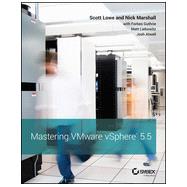The 2013 edition of the bestselling vSphere book on the market
Virtualization remains the hottest trend in the IT world, and VMware vSphere is the industry's most widely deployed virtualization solution. The demand for IT professionals skilled in virtualization and cloud-related technologies is great and expected to keep growing. This comprehensive Sybex guide covers all the features and capabilities of VMware vSphere, showing administrators step by step how to install, configure, operate, manage, and secure it.
This perfect blend of hands-on instruction, conceptual explanation, and practical application is reinforced with real-world examples. Led by Scott Lowe and Nick Marshall, both VMware vExperts, the author team provides expertise that will prepare IT professionals to excel in using this virtualization technology.
- Virtualization is seen as a "best practice" for high availability and disaster recovery solutions, as well as for applications such as Exchange Server and SharePoint
- IDC estimates that there are as many as 7 million jobs available worldwide in virtualization and cloud technology
- Provides hands-on instruction in all the latest features and capabilities of VMware vSphere, with both conceptual explanations and practical applications
- Author team is lead by Scott Lowe and Nick Marshall, well-known VMware experts and popular bloggers
Mastering VMware vSphere provides what every virtualization professional needs to know.








